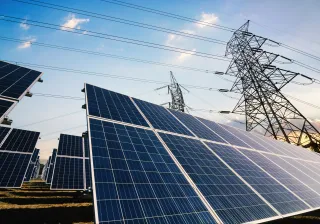The European energy system is currently changing at a rapid pace, and the growth of wind and solar power will create increasing demand for flexibility. The integration of energy sectors can provide cost-effective ways to increase the flexibility of the energy system, but it will require a great deal of cooperation and information before it can be implemented.
Despite the currently on-going energy crisis, there has been good news on the progress of the energy transition: the costs of wind and solar power have fallen faster than expected, and their capacity is now growing at a considerably faster rate than what even their biggest proponents dared to forecast only 5–10 years ago. For example:
- In 2021, the costs of energy produced by solar panels decreased by 13% and onshore wind power by 15%. (1)
- During the first nine months of last year, solar panel imports from China to Europe exceeded 60 GW when the forecast for the entire year was 40 GW. At this rate, Europe’s solar capacity could double in around two years – from 160 GW to over 300 GW – between 2021 and 2023. (2)
- In the next three years, 4 GW of new wind power will be constructed in Finland, generating approximately Olkiluoto 3’s worth of electricity per year. And there are multiple times more construction projects in the pipeline. (3)
As an energy system researcher, it’s great to see that we are finally moving on from the issue of increasing renewable generation to solving the challenges related to its integration. Variable generation requires a new approach to controlling the energy system in order to guarantee both the stability of the power grid and the balance of generation and demand at every moment and in all circumstances.
In this blog post, I will attempt to explain how the balancing of generation and demand will create challenges in the future and how they can be solved through cooperation between systems and end-users. Indeed, “sector integration”, the somewhat clunky term for this cooperative approach, refers to different energy sectors supporting or providing flexibility to each other.
Sector integration aims to benefit the entire energy system instead of an individual sector
The figure below illustrates the components of the energy system and the sources of flexibility in the renewable energy system. In simple terms, the flexibility in our current system is based on generation, and neither the system nor the consumers have had to be reactive in any way. However, in the future, all three must be able to flexibly support one another.

Sources of flexibility in the renewable energy system. The different system and end-use sectors work together and support one another. (4)
Methods for increasing flexibility include increasing the opportunities and incentives for demand response, strengthening electricity transmission connections, direct electrical storage, and developing the cooperative operation of sectors. We need to select the methods that are the most cost-effective for the entire system in the long run and that will support the long-term stability and development of the system in a variety of future scenarios.
From Finland’s point of view, a key example of sector integration is flexible district heat generation with the use of heat storage. Here the district heating sector provides flexibility for the electricity sector. Traditionally, combined heat and power (CHP) is operated solely based on district heating demand. However, large heat storages would allow cogeneration plants to be operated also according to the needs of the electricity system. By storing the heat, both demands can be satisfied with added flexibility, but without compromising efficiency. District heat could also be generated using large heat pumps. Their operation could likewise follow the demands of both the electrical and heating system, with the heat storage facilities serving as a buffer. This type of sector integration solution may be able to increase flexibility less expensively than, for example, direct electrical storage.
The example illustrates the many opportunities for sector integration, but it should be noted that there are still many conditions for its profitability: Firstly, the share of district heating and joint generation must be significant, and there must be suitable heat sources for the heat pumps and locations for the heat storage. Secondly, the energy markets in a highly renewable system and the cost of different flexibility options still remain uncertain. Therefore, we can be somewhat certain in stating that different sectors should support each other in the future, but that the solutions and their scopes still remain uncertain and location-dependent.
Flexibility is needed at different time scales
The need for flexibility in the future energy system will increase on all timescales, from a second-to-second or even season-to-season basis. From the perspective of a system researcher, perhaps the most interesting issue is the management of long-term variations that involve timescales from weeks onward, so called seasonal flexibility. To simplify, the need for seasonal flexibility arises from the differences in summer and winter energy demand, seasonal fluctuations in solar, wind and hydropower, and preparing for security situations. However, the need for seasonal flexibility is not limited to fluctuations within a single year, but also to several consecutive years of poor weather conditions or system-related disruptions.
Traditional large-scale seasonal flexibility providers are fossil fuel storages, such as coal stocks and geological storage sites for natural gas. Their advantage is that they can be used to inexpensively store large masses of energy for long periods of time without significant losses. However, there are no direct renewable replacements readily available. Hydropower reservoirs and biomass storage are still available in a fully renewable system, but their potential is limited.
The most interesting sector integration solutions include hydrogen, district heating and end-users
When converted into hydrogen (or a hydrogen-based derivative), electricity could, in principle, be stored and transported in the same way as fossil fuels today, in which case hydrogen could serve as both an intermediate and seasonal energy storage. However, the conversion, storage and transport of this type of energy vectors is currently expensive and involves significant efficiency losses, so far making them commercially unviable. In particular in providing short-term flexibility, it seems that there are more cost-effective alternatives. In the near-term future, the most promising sector integration use for hydrogen is in industrial demand response: The first large-scale users of the hydrogen economy will most likely be in industry, where electrolysers could be operated according to the availability of variable renewable electricity, using the storage of the final product as a source of flexibility. While insecurities on the role of the hydrogen economy remain large, in the long term it offers great potential, and there is much political drive behind it - making it worth following closely in the coming years and decades.
Another interesting question is related to the aforementioned connection between the district heating and electricity sector. District heating could be a significant provider of flexibility in the future, but on the other hand, direct electrification and the maintenance costs of the district heating network could also diminish district heating’s current role. Thirdly, we must highlight the amount of demand flexibility provided by end-users. There is huge potential for flexibility in building heating, mobility and industry if the electrification of society will continue to progress as planned. However, the inclusion of end-users as providers of flexibility still requires developments in technology, markets and consumer readiness.
The next phase of the energy transition requires a focus shift from increasing renewable generation to considering system flexibility
Although the energy transition is still far from complete, many of its wildest dreams have already come true – the share of wind power in Europe is in the double digits percentage-wise, and consumers feel truly confident in purchasing solar panels for their homes. In the midst of the energy crisis, it is worth celebrating these achievements. Now we are preparing to move to the next phase of the energy transition, which includes not only increasing the share of renewable production but also focusing on the flexibility of the energy system. In this blog post, I have attempted to illustrate the concepts of flexibility, such as the drivers of flexibility increase, sector integration as a source of flexibility, how flexibility is needed at different timescales, and which sector integration solutions seem most interesting at this point in time.
Different solutions for sector integration can provide benefits at different timescales. However, increasing sector integration will always require cooperation and careful coordination: how will the steering, data transfers, planning and use of different parties seamlessly serve both their common and individual interests while also maintaining the stability of the entire system? Part of the development of the coordination will be related to technological solutions, but it will also require regulation and developing the flexibility market. At best, renewable generation can help provide substantial savings to the energy system, but some of those savings must be invested in providing and coordinating flexibility - in order to build a robust, secure and affordable energy system.
References
(1) https://www.irena.org/publications/2022/Jul/Renewable-Power-Generation-Costs-in-2021
(2) https://www.statista.com/statistics/497540/connected-and-cumulated-photovoltaic-capacity-in-the-european-union-eu/
SolarPower Europe 2021
https://taiyangnews.info/markets/massive-volumes-of-chinese-modules-entering-europe/
(3) https://tuulivoimayhdistys.fi/en/wind-power-in-finland/projects-under-construction
(4) Image adapted from Nordic Energy Technology Perspectives 2016 (IEA and Nordic Energy Research)





